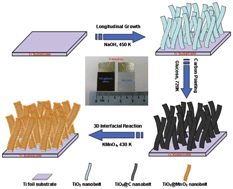Hierarchical TiO2 nanobelts@MnO2 ultrathin nanoflakes core–shell arrays (TiO2@MnO2 NBAs) have been fabricated on a Ti foil substrate by hydrothermal approach and further investigated as the electrode for a supercapacitor. Their electrochemical properties were examined using cyclic voltammetry (CV), galvanostatic charge–discharge, and electrochemical impedance spectroscopy (EIS) in a three-electrode cell. The experimental observations clearly show that the fabricated TiO2@MnO2 NBAs electrode possesses superior rate capability and outstanding cycling performance due to its rationally designed nanostructure. A specific capacitance as high as 557.6 F g−1 is obtained at a scan rate of 200 mV s−1 (454.2 F g−1 at a current density of 200 mA g−1) in 1 M Na2SO4 aqueous solution. The energy density and power density measured at 2 A g−1 are 7.5 Wh kg−1 and 1 kW kg−1 respectively, demonstrating its good rate capability. In addition, the composite TiO2@MnO2 NBAs electrode shows excellent long-term cyclic stability. The fabrication method presented here is facile, cost-effective and scalable, which may open a new pathway for real device applications.

You have access to this article
 Please wait while we load your content...
Something went wrong. Try again?
Please wait while we load your content...
Something went wrong. Try again?


 Please wait while we load your content...
Please wait while we load your content...